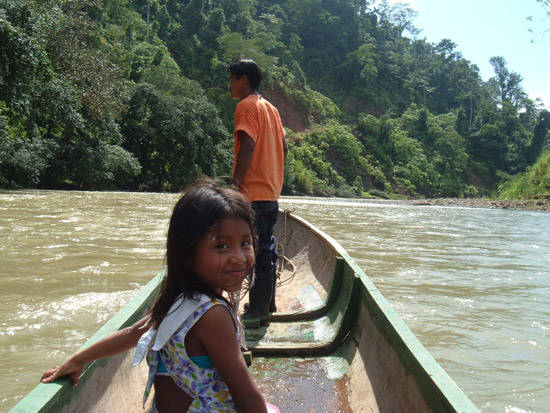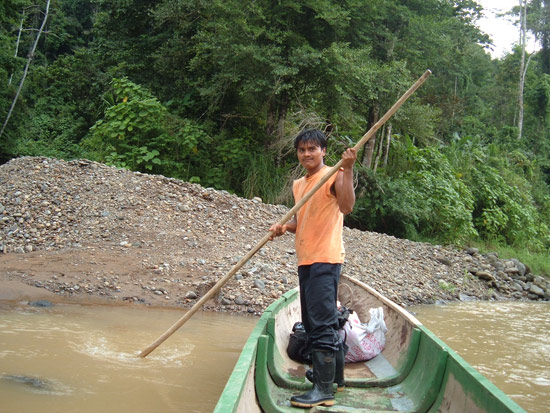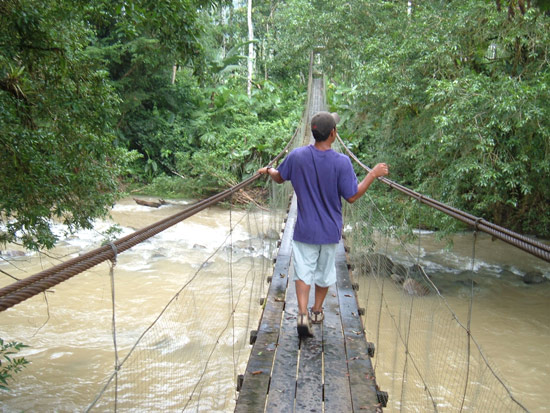
I knew I was going off the beaten path when even my taxi driver looked worried.
“So where exactly should I drop you off?” he asked, as his pickup attempted to ford streams and waterfalls flowing over the Costa Rican mountain road.
“Maybe by the river?” I told him, shrugging. “My instructions just say to go to the town of Bambú, and they’ll find me.”
“They” are members of Costa Rica’s Bribri tribe. I would be spending two days with them in a remote village called Yorkín, which is only reachable by dugout canoe. I was told I’d be learning about their crafts and customs, watching demonstrations, and exploring the local terrain, but I still felt unprepared. As the nice lady who arranged the tour told me, once you get into the canoe, “you’re in their hands.”
She did give me instructions to go to a village called Bambú — but nothing more. “It sounds vague,” she said. “But it works.”
And it did.
Taking the scenic route
My taxista had nothing to worry about. A man in wading boots and a dirty cutoff T-shirt greeted me in Bambú.
“Soy Luis,” he said. Seconds later, Roberto, my other guide, appeared, and I was escorted to a big, crude, green canoe.
The Yorkín river, which borders Panama and Costa Rica, was a thick silty brown from heavy rain that had fallen the night before, but I didn’t care. As Luis pushed away from the shore with a long stick, I realized that I would be entirely dependent on these people for the next two days. With no roads, phone lines, Internet access, or stores, I would have to trust strangers.
After 15 minutes in the canoe, my guides slid the craft onto a slice of riverbank that was covered in white stones. Right next to us, a quickly moving, rocky stream emptied into the river. I assumed that somewhere between the rushing stream and the dense vegetation was a path that would lead us to their Costa Rican village.

I was quite wrong.
“This is Panama,” Roberto told me. “We’re going to go to the waterfall.”
I had no idea we’d be taking such a side trip, but I was thrilled. (And crossing a border without going through customs felt delightfully rebellious.) I didn’t know the name of the waterfall or why it was so important that we visit it, but this trip was all about going with the flow, even if for the next 20 minutes I was wading against the current of a Panamanian waterway.
Looking at my sneakers, Roberto added, “Um, your shoes are going to get wet.”
That was an understatement. I tried to daintily hop from craggy rock to craggy rock at first, but I quickly gave up and followed my guides’ lead. Jeans, socks, sneakers and all, I plunged my legs into the water. I surrendered my purse, which held my precious camera, to one of the guides, who kept it above water with the grace of an acrobat as I clumsily stumbled behind them.
After 15 minutes of climbing over the treacherous, half-submerged rocks, we made it to the base of a thick waterfall. They splashed their faces and drank. I perched on a stone, forgot about my soggy clothes, and absorbed the mist of the Panamanian waters. Nearby, a lizard with a long, bright blue tail posed perfectly still on a rock.
Some guides suggest that if you’re looking for awe-inspiring Central American culture, you should skip Costa Rica. It’s better known for its beaches, rainforests, and volcanoes, so instead, explore the colorful native cultures that continue to follow their traditions in destinations such as Guatemala or Panama. Indigenous people make up only 1 percent of the population in Costa Rica, a comparatively stable country; Indian tribes here never erected anything comparable to the Mayan or Aztec pyramids that you’ll find in Mexico or Guatemala.
But, back in the canoe, still dripping from our waterfall excursion, we headed for Yorkín, a place that would prove that this culture too was determined to survive.

Paradise amongst the flora
The canoe stopped in a grassy bank, and I was met by two girls who stared at my blonde hair and giggled, but said little. An old man escorted me down a muddy road, and before disappearing behind the banana trees, pointed to a rustic health center.
“A doctor comes every fifteen days,” he said. “But we’re usually pretty healthy people.”
The soundtrack of Yorkín was the rushing river, giggling children, and cackling roosters. The air was fresh and damp. Children spent the day picking and sucking on exotic fruits, while turning anything possible into a soccer ball — crushed plastic bottles, large seeds.
My housing for the night was an open-air lodge with a thatched roof. I traded my sopping wet sneakers for the flip-flops in my bag. Alone on the big platform, I felt awkward.
There was no place to sit. The area was so open that I was afraid to change out of my wet pants because I felt like the whole tribe might watch. My fears were unfounded. In this village, neighbors have jungle between their homes. I peered over the low ledge. Bright vegetation was everywhere.
Over banana cakes and a bitter juice, I was introduced to Noe, who would be my primary guide in the village.
Noe took me on a vegetation tour and pointed out the uses of native plants. He explained that large green gourds were turned into bowls, and I sampled a sour version of sugar cane that the Bribri chew on to extract juices. I learned about a bush-like grass that has long slender leaves that spread out into a fan. Noe explained that they tear the fan into strips, then dry and dye them for weaving.
“There are very few plants we don’t use,” he said.
He pulled a yellow pod off of a tree and cracked it in half to reveal almond-sized beans, covered in a slimy mucus.
“Cacao.”
Noe showed me how to take the seeds out and suck the slimy white stuff off of them — it tasted nothing like chocolate (that flavor comes from deep within the seeds), but it was sweet.
“Later,” he told me, “you’ll see a chocolate-making demonstration.”
Keeping culture alive
The tourism program is run by a cooperative of women. Calling themselves Estribata, they formed about 20 years ago when they feared they were losing their culture: people were forgetting uses of medicinal plants, children stopped learning the Bribri language, and men were leaving Yorkín to work on sticky banana plantations, which were full of pesticides. After a 28-year-old villager returned sick and then died from cancer, Bernarda Morales Marin decided that was the last straw.
“Our culture is just as valid as all the other cultures in the world,” said Bernarda, the group’s founder.
Sharing with tourists, they decided, would be the best way to help the community economically and give villagers a strong incentive to preserve their heritage. With the help of nonprofit groups, they built the housing structure with a tall, thatched roof, and started inviting guests. The first year about 10 people came. That number eventually grew to several hundred visitors a year.

Villagers also started exporting organic cocoa to Italy and bananas to Germany. With the mixed sources of income, families went from earning nothing to bringing in about $20 USD a month.
Bernarda explained all of this to me by candlelight. There were no electricity lines in the village, but tourism income helped raise money for solar panels in the tourist lodge’s kitchen and in the local school. Another positive result: Children now learn the Bribri language in school.
Visitors’ activities range from making thatched roofs, to hiking, to exploring local hot springs. I told Bernarda that I’d like to take a hike the next day and learn how to weave.
“Of course,” she said.
And then, it was chocolate time. A woman brought out a tray of roasted cacao beans. She rubbed her fingers over them and then dropped them through a metal grinder, letting the resulting coarse powder land on another tray. Once she finished, she held that tray over the ground and, with a few expert shakes, sent the shell bits drifting into the dirt.
She prepared to run the powder through the grinder again. But first, she turned to me. “How do you think it’s going to come out?” she asked slyly in Spanish. “A powder, like coffee?”
I nodded.
It was my turn to grind. As I turned the handle, tiring quickly and worrying that I seemed like a weak city girl, I saw that there was no powder at all. Instead, a rough brown paste with an intoxicating chocolate scent was falling from the grinder. My chocolate teacher smiled.
When it was all finished, she mixed it with sweetened condensed milk, creating a soft, thick chocolate pudding that I still dream about.
Treasures and treasured memories to take home
During much of my time there I felt slightly awkward, an oversized foreigner dependent on her hosts to survive. Sometimes Noe abandoned me when he ran out of things to say. A little girl followed me around, asking my phone number and assuring me that she would have it memorized by the time I left (she did). The entire village, where about 200 people live, shared one cell phone.
Nighttime in Yorkín was a little scary. My eyes never adjusted to the blackness, and when I stumbled outside to use the bathroom in the middle of the night, I could only think about jaguars and snakes.
I woke up in one piece the next morning. After eating banana pancakes for breakfast, I borrowed someone’s rubber boots for a hike up the mountain. I hoped, futilely, to see a jaguar, but we did spot a fleeing agouti and a lot of tiny red frogs with blue legs. I almost walked into a beetle, the size of my hand, hanging above the trail. After inspecting the beetle’s elaborate design and colors, I wasn’t surprised to learn that it was called a harlequin beetle.
The trail was a mix of knotted tree roots and oozing mud. Tourists wear their expensive hiking boots at their own risk. The locals know better. They sport rubber boots or simply go barefoot.
When I came back, I sat down with a young woman named Fidelia for a weaving lesson using the same plant Noe had shown me the day before. When she wound the strips around themselves, it looked easy. Then she handed them to me. My fingers seemed a lot fatter than hers. I got to take home a tiny basket, of which I had woven a single layer. I also bought a necklace made from rainforest seeds for my mom and a similar bracelet for myself. I purchased them off a small table where a makeshift “gift shop” had been created for my benefit. I was the only visitor there.
I lingered over lunch, which included fried ferns served on a plate made from a banana leaf, and lingered over the gift table, slightly worried about how I was going to get back to town to catch a bus to the capital city of San Jose. My guides were supposed to take me to the mainland in a canoe, but they didn’t seem worried, so I tried not to fret. The clock was ticking though, and I didn’t want to be stuck in the campo.
By the time I got back to Bambú, there were no more buses going to the pickup point for the San Jose bus. It was far too long to walk, and there was not enough time to call a taxi. Like a sequel to my Bribri adventure, I ended up hitching a ride with a friend of Noe’s about halfway, walking another part of the way, and was lucky enough to catch a cab for the final mile and a half. I boarded the San Jose bus with five minutes to spare. Before long, I had taken a bundle wrapped in a banana leaf out of my bag. It was the chocolate made the day before.
It disappeared just as quickly as my time with the Bribri faded to memories. And soon I was in San Jose, a place that already felt like a different world.

- Follow us on Twitter: @inthefray
- Comment on stories or like us on Facebook
- Subscribe to our free email newsletter
- Send us your writing, photography, or artwork
- Republish our Creative Commons-licensed content

